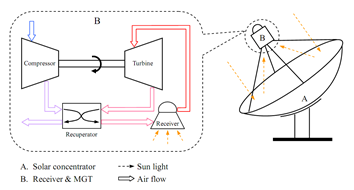OMSoP
 The OMSoP project, co-funded by the European Union’s 7th Framework Programme for Research and Development aims to provide and demonstrate technical solutions for the use of state-of-the-art concentrated solar power system (CSP) coupled to micro-gas turbines (MGT) to produce electricity. The intended system will be modular and capable of producing electricity in the range of 3-10 kW.
The OMSoP project, co-funded by the European Union’s 7th Framework Programme for Research and Development aims to provide and demonstrate technical solutions for the use of state-of-the-art concentrated solar power system (CSP) coupled to micro-gas turbines (MGT) to produce electricity. The intended system will be modular and capable of producing electricity in the range of 3-10 kW.
In February 2013, the OMSoP project kicked off with 8 partners from 5 countries with a total budget of 5,8 million euro. Successful dissemination and implementation of the project results should result in the demonstration of the stand-alone-system, addressing the key innovation bottlenecks: the high temperature solar receiver, the stand-alone solar dish concentrator and the more reliable micro-gas turbine.
Optimised Microturbine Solar Power system
Acronym: OMSoP

Collaborative Project: FP7-308952
Duration: 4 years (2013-2017)
Budget: 5.8 M Euro (4.2 M Euro EU funding)
Co-funded by the European Commission, Directorate-General for Energy
OMSoP Sharepoint
Consortium Members can access the OMSoP project’s sharepoint platform here. The ETN Office can be contacted in case of issue with access credentials.
OBJECTIVE
The overall objective of this project is to provide and demonstrate technical solutions for the use of state-of-the-art concentrated solar power system (CSP) coupled to micro-gas turbines (MGT) to produce electricity. The intended system will be modular and capable of producing electricity in the range of 3-10 kW. The aim is to make such a system available to provide energy needs for domestic and small commercial applications. For larger energy needs, the units can be stacked by virtue of their modular nature. It can be integrated with medium and long term energy storage and/or co-firing with conventional fuels. The primary technical challenge is to enable the production of small scale cost effective, efficient, reliable and easy to maintain units.
To achieve these objectives, research and development will be conducted in all aspects of the system leading to a full scale demonstration. The parabolic dish concentrator technology will be improved to reduce weight, improve tracking system and increase concentration ratio. A receiver suitable for this application will be optimised. This requires the development of absorption materials and improving heat transfer and cooling technology. A novel feature of this project is the replacement of the Stirling engine which is typically used in this size of application, to convert thermal energy to mechanical power, with an MGT. Stirling engines suffer from problems such as high cost, complexity and poor reliability. A recently developed MGT will be optimised in conjunction with the CSP system. The demonstration activity will focus testing on the primary components. Although thermal storage and hybridisation with other fuels are beyond the scope of this project in terms of demonstration, they will be considered in the overall system optimisation from both technical and economic points of view.
 | The Energy and Transport (ET) research centre comprises those areas of research focussed upon improving the efficiency of transportation, compression and energy-generation processes. The ET centre is formed from the following groups: Energy Systems & Engines, Aeronautics & Air Transport, Positive Displacement Compressors and Computational Fluid Dynamics. In the OMSoP Project, City, University of London will act as scientific coordinator and will lea the micro gas turbine desgin and testing. They will also participate in system modelling, integration and demonstration. |
 | University Roma Tre is the second largest University in Rome. About 36000 students are enrolled in eight Departments covering humanistic, scientific and technical fields. In the OMSoP project, the Research Group of Fluid Machinery and Energy Conversion Systems is involved in the design of advanced solar receivers integrated with short-term storage systems, in the system analysis and plant techno-economic optimization. |
 | The Italian National Agency for new technologies, energy and sustainable economic development is a public undertaking operating in the fields of energy, environment and new technologies to support competitiveness and sustainable development. In the OMSoP project, ENEA will be involved as WP2 leader, where, in collaboration with other partners, will deal with modeling and simulations of solar unit and will contribute to the design of the integrated system. ENEA will conceive and study the plant layout in order to define the best option in terms of overall thermal efficiency and cost. ENEA will be involved in the realization of the demonstration plant, which will be assembled at ENEA Casaccia Research Center in Rome with the main objective of demonstrating the system full functionality and controllability. |
 | Innova is specialized in the fields of solar concentration and of conversion of heat into power through efficient methods.In the OMSoP project, INNOVA will be responsible for the design and build of the solar dish |
 | Compowers mission is to develop, manufacture and sell microturbines in the power range below 30 kW. It has among other things designed and built a 5 kW system which is now being tested. In the OMSoP project, Compower will primarily work with development of the microturbine for the demonstrator and with the microturbine aspects in the techno – economic analyses and optimization. Compower will also be engaged in the market analysis work. |
 | The division of Heat and Power Technology (HPT) at the Royal Institute of Technology, conducts research in the field of poly-generation (combined production of electricity, heat, cooling, clean water, fuel, etc.), stationary flows and aeroelasticity of turbo machinery, concentration solar power and use of biofuels in gas turbine cycles (gasification and combustion technologies). In the OMSoP project, HPT will develop high temperature solar receivers that will be tested and validated in the division’s high-flux solar simulator together with the micro-turbine. |
 | In the OMSoP Project, The university of Seville will develop the market and cost analysis of the OMSoP generator in order to make it cost-competitive and to identify the potential niche markets in which the system is likely to have a significant impact on the power generation sector. |
 | ETN is a non-profit association bringing together the entire value chain of the gas turbine technology community in Europe. Through the co-operative efforts of our members, ETN facilitates gas turbine research and technology development, promoting environmentally friendly gas turbine technology with reliable and low cost operation. In the OMSoP project, ETN will be responsible for the dissemination of the project results. |
The technical challenges being addressed by the OMSoP project are divided into 3 Work Packages:
WP1 System Component Development
There are two main tasks for the WP1. The first is to develop and separately test the components for a demonstration system in the range of up to 10kWe. The micro gas turbine will be based on improvements to an existing system developed by Compower. Development and testing will be conducted at City University London. KTH will develop and test a receiver in their Solar Lab while INNOVA will develop a solar concentrator based on their solar dish-Sterling technology. The second task is to use the acquired knowledge to develop components for an optimised microturbine solar dish system for the power range up to 30kWe for future testing and deployment.
WP2 System design and integration
This WP has two main tasks. The first is to integrate the system demonstration components developed in WP1 and perform the tests for the overall system. Data obtained will be used to inform the optimised system design which is the subject of the second task. The second task will coordinate the development of the optimised system components from WP1 and the techno-economic information from WP3 to produce a final design for an optimum system for future testing and deployment.
WP3 Techno-Economic analysis
Thermodynamic and mechanical models of the system and its components will be developed and used for the analysis and design of both the demonstration system and optimised system in WP2. Further insight into future deployment will be gained by investigating concepts such as medium and long-term storage, hybridisation with other fuels and MGT power augmentation concepts. Market and cost analyses will also be performed in addition to uncertainty, sensitivity and risk studies. The above will provide crucial information to system and component development and will also provide insight into potential future deployment. Finally, a life cycle assessment will be performed to evaluate the environmental aspects and potential impact associated to the solar system.
Public Deliverables
Work Package 1
D1.2 – Report on short term storage testing and evaluation
D1.4 – Report on solar dish selected materials
D1.8 – Optimised Radial Turbine Design
D1.9 – Bearing system selection
Work Package 3
D3.2 – Report on potential markets for small scale solar-dish microturbines
D3.3 Final report on the economic appraisal of a 5-10kWe Dispatchable Power Generation
D3.4 – Report on state-of-the-art dish-engine applications
D3.5 – List of the available models and their main characteristics
Work Package 4
Public Reports
OMSoP – Second Periodic Report
CSP Today – Two new CSP research projects kick off in Europe – May 2013
European Energy Innovation – RO3
Gas Turbine World – Bright prospects for micro-turbines
City University – City hosts workshop for visiting senior EU and Chinese government officials
City University – City mechanical engineers pioneer innovative turbine engine research
the ENGINEER – Increased concentration
Brochure
OMSoP demonstration site Poster
For further information, please contact the Project Coordinator:
 |
Prof. Abdulnaser Sayma
Professor of Energy Engineering City University London |








